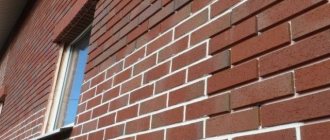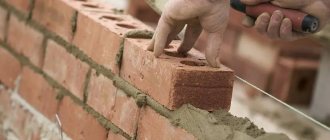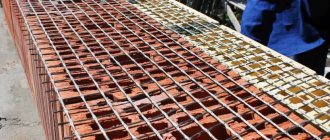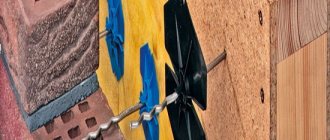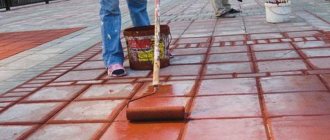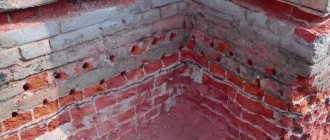Everyone is used to the fact that concrete usually has a boring gray color. Only a few people try to paint it, but anyone who has ever painted a concrete surface knows how difficult it is to achieve rich and durable colors.
You can paint a concrete floor using pigment dyes added to the concrete solution.
There is a much more profitable option: to paint the cement mortar at the mixing stage.
To do this, add a coloring pigment to the solution, which must meet certain requirements:
- do not dissolve in water;
- be resistant to burnout;
- be resistant to alkaline environments.
By mixing pigments of different colors, you can achieve the desired, unique and bright color. This method is used to paint paving stones, paving slabs, reinforced concrete products - everything that is made from cement mortar.
Solution color scheme.
Pigments are special powder dyes that are added when mixing cement, saturating its silicates and aluminates. The pigment acts like ordinary potassium permanganate, and its concentration in the solution is proportional to the desired color. Depending on what the pigment is diluted in, a ready-made solution of different types is obtained: alkyd (based on white spirit), oil-based (based on drying oil), acrylic (based on water) and nitro (based on solvents and acetones).
Pigments for coloring cement mortar can be organic or mineral. According to the type of their production, they are divided into natural and artificial. Fundamentally, these two types do not differ, since both the first and second versions use metal oxides. Natural oxides are mined in quarries using the ore method, and artificial (or synthetic) ones are mined in the steel industry by chemical processing of raw materials. Today, the market offers a large selection of cement dyes in different forms: dry powders, microcapsules, emulsions or concentrated pastes. It is important not to make a mistake when choosing, since the solution can be painted with different substances in different cases. It is better to decide in advance on the desired end result of dyeing, and the type of dilution of the dye. The solution after adding the pigment is used like a regular solution.
Coloring the solution
This method is good because it reduces the labor intensity of the work - the white seam in the brickwork is obtained directly during the construction of the facing structure.
In order for the cement mortar to become white, coloring components must be added to it. They may be:
- slaked lime, which is known to increase the plasticity of the solution and improve its performance properties;
- Colored colors for masonry are one of the ways to give cement mortar any shade. The point is that expectations may not be met - strict adherence to the proportions of preparing the mixture is required, the best effect is achieved when using special white cement, against which the color will be most visible;
- Titanium oxide is a universal bleach that can perfectly lighten the cement mass.
The listed components will help to make a white seam during masonry, which will save time and labor costs, but you will have to pay for it - additives are needed in significant quantities, which increases the cost of the working material.
The best option is to use titanium oxide. This component is not washed out and does not affect the strength of the wall in any way. In addition, you won’t have to expect any unpleasant surprises from the solution - delamination, the formation of efflorescence (as when adding lime).
Preparation and laying
To make masonry mortar white and reduce material consumption, masons use 2 types of working mixture at the same time - classic and colored.
Gray cement-sand mortar is prepared using traditional technology. It is placed on an invisible part of the masonry.
To make the white mixture, you need to prepare:
- white cement grade M500 – 1 part;
- titanium oxide (whitewash) – no more than 10% of the amount of cement;
- sand – 3 parts;
- water as needed.
The dye is dissolved in water and the sand is mixed with cement, or the dry component is mixed with a binder before mixing with the liquid.
A house made of red or brown brick with white joints can be faced using exclusively white mortar or it can be laid only on the outside of the masonry surface.
Primary pigment color
It happens:
- white. To create white cement, titanium oxide is added;
- black. Add soot or carbon monoxide;
- green. The green tint is obtained by adding chromium oxide;
- brown. It is obtained by adding iron oxide;
- red. Iron oxide gives this color;
- yellow. Created by iron oxide.
These are the most common and time-tested colors. Other color options are more expensive and fade quickly.
Grouting joints
The essence of this method is the treatment of formed gray seams with colored compounds.
- the ability to give the masonry any color;
- wide selection of dry color mixtures;
- seam protection from aggressive external environments, waterproofing and strengthening;
- the seam can be renewed, the color of the grout can be changed;
- the cost of the material is significantly lower than coloring the solution itself.
The disadvantage is that the work is labor-intensive; grouting is carried out separately after the construction of the structure.
You can make a brick joint white or colored using different mixtures:
- cement-based - the most common, suitable for interior and exterior work;
- on epoxy resin - grout for interior spaces. This coating can be washed and cleaned, it is not afraid of water and high humidity.
Cement grout is sold as a dry mixture. It is enough to dilute them with water in the proportion stated on the label to obtain a white or colored solution.
There is another way - using a color that is introduced into the cement mixture.
How to grout
A house made of brown brick with white seams or facing with red masonry with jointing of the same color - there are many options for facade design. But the difference is not only in the chosen color, but also in the shape of the seam created by the mason. It depends on the shape of the instrument used for design.
For stitching you will need:
- The masonry is cleaned of dust and other contaminants.
- The seams at the work site are wetted - this will help to achieve high adhesion between the grout and the base.
- Prepare the solution according to the instructions. Mixing the components must be done using a metal sieve and a construction mixer.
- The mortar is applied to the spatula along the entire length, the tool is pressed tightly against the edge of the bottom brick.
- Using a jointer of the desired shape, push a small amount of mortar into the joint and rub the mixture.
Pros and cons of colored cement
To reduce the cost of facing a room, cement is painted, giving it a decorative appearance. The hardened solution with dye will keep the color unchanged after damage. The advantage of dyes is:
- it is absolutely safe for humans and does not harm the environment;
- economical spending. By using a small amount of pigment, a mass with a rich color is obtained;
- You can give the structures any shade that is needed to realize the design idea.
- Its disadvantages include:
- Over time and under the influence of the sun, the painted surface changes color. It becomes less saturated and a yellow tint forms;
- the use of dyes increases the estimated costs.
To paint or not
Dark brick with white seams looks solemn; this is a classic version of the facade design. And it doesn’t matter whether the stone used is brown or red - a gray mortar of cement and sand definitely does not decorate the facade.
When choosing a method for painting seams, you should rely on 2 main factors:
- construction timeframes. If they are getting tight, it is best to paint the masonry mortar;
- financial opportunities. In this case, you should calculate the amount of painting and grouting work and choose the appropriate option.
It should be noted that mashing will require not only material, but also labor. However, the work can be done independently, without using the services of specialists.
Man has always strived to give his home aesthetic appeal. With the spread of design, the feeling of beauty acquired an individual character. The interiors are now different from one another. Some try to imitate brick, others hide it at all costs.
Brick texture is an amazing thing. Thanks to her, the interior turns out to be unusual and stylish. However, there are few people who would agree to brickwork in their bedroom. Therefore, designers decide on a tricky trick - painting the wall.
If we are talking about the inside of the house, then we can talk about physical permission. Painting brick is much easier than plastering it. In addition, the paint will mask visible defects and renew the boring façade. External painting has one very unpleasant nuance. Covering the walls with an airtight layer of paint will affect the performance of the house. The air will cease to be ventilated, this will lead to increased dampness and rotting. But if you act responsibly and follow all the instructions, you can avoid the unpleasant greenhouse effect.
Introduction to pigments
Pigment is a dry substance that resembles a powder and does not dissolve in liquids. Its purpose is to paint; there are various compositions: concrete, mortars, paints. When using it, a film forms around the material. It is used for painting cement products:
- foundations;
- borders;
- facade, paving, facing tiles.
The color is produced in the form of powder, concentrated color paste, capsules, and emulsion. It is distinguished by the raw materials from which it is prepared: natural. It is mined by grinding natural materials in the form of chalk, ocher, graphite, and iron surzhik. Synthetic color. Obtained chemically. Metal. Golden bronze, zinc dust, aluminum powder, as well as titanium, chrome and iron oxides are used. Acid. The color of minerals in solution changes under the influence of the acid solution.
Nuances to paint brickwork correctly
Before painting, consider whether this treatment method is really necessary. Brick production did not imply the option of such finishing. You can choose colors and textures during the construction stage. If the building is still under construction, consider purchasing colored bricks.
Simple masonry holds quite firmly and does not fade. It is intended to be used without further processing.
If you decide to paint it, you will have to repeat the action at least once every five years, since the layer of any paint is not as durable as the surface of the material.
In addition, you will have to work hard to remove the old layer of cracked, faded, peeling or tired paint. The surface of the brick is very porous, so the dye molecules penetrate deep inside, and it will no longer be possible to radically change the color.
It is not recommended to apply dye to newly constructed walls.
The optimal time for leaching, precipitation, and drying is about one year. If you paint them earlier, you can get significant defects that cannot be masked further. The apparent ease of applying the coloring pigment is a deception. The process is significantly complicated by initial preparation. The brickwork needs to be prepared, and this will take a lot of your time.
Types of paints
The most common is the acid base for dyes. Their feature is:
- Available in all popular colors;
- used for painting facades and interiors;
- they are applied with sprayers or special brushes;
- the acidic environment is washed off with water after painting the cement;
- The compositions are wear-resistant and fade slightly.
For brickwork, water-based acrylic dyes are used. The acrylic base of the color easily penetrates into the concrete mixture; it does not need to be washed off. The result will be a color-rich surface. When making paving stones, colors are used. The cement mixture with added pigment is poured into molds and dried. The result is paving stones with high permeability.
To make your own acid cement dyes you will need the following ingredients:
- adhesive base;
- color additive;
- solvent.
The ingredients are mixed until smooth. Work with this dye is carried out in protective glasses and special clothing.
Stages of preparation for painting
- We remove any existing mold and carefully examine all seams and nooks and crannies for its presence. To prevent it from developing under a layer of paint, use special products that eliminate fungal deposits;
- We clean the brick wall from efflorescence. These are white, salt formations caused by the leaching of new brick. After this, we wait for some time to make sure that they are absent. The most convenient way to remove them is with a dampened stiff brush. The use of chemicals is not recommended, as they contain more acids;
- After water treatments, the brick wall needs to dry thoroughly. Try not to pour large amounts of water into the seams, this will significantly reduce the drying time. Do not ignore this point, because the remaining water will not be able to evaporate and, in the process of changing climatic conditions, will form microcracks in the cavity of the laying material;
- rid the walls of construction debris and dust; if any bricks are chipped or cracked, be sure to putty and sand them. You can renew the seams on the old wall;
- Prime the surface with an alkali-resistant solution.
How to prevent efflorescence on surfaces
Efflorescence is the name given to emerging white spots that spoil the appearance of a finished wall. To prevent the appearance of such stains, you must adhere to some rules:
- The cement should only be clean, without unnecessary impurities and lumps.
- When working, use purified or soft water.
- The concrete structure should be kept for about two days until it hardens to a minimum.
- Finished products must be laid on material that absorbs moisture.
- If efflorescence does appear, then acidic substances cannot be used to remove it.
To remove white spots, special silicone impregnations are used, which penetrate deep into the pores of the material and prevent the appearance of efflorescence. Sometimes light stains can serve as a decorative element on the surface.
How to Paint Exterior Brickwork
Pay attention to the material from which the structure is made. This will help you choose the paint more accurately. Buy specialized facade paint that has the qualities necessary for exterior work:
- vapor permeability, that is, the ability of the material to “give” even under a thick layer of paint;
- resistance to wetness;
- resistance to color loss (fading);
- non-contact with alkali;
- wear resistance.
Please note that for the beauty of the facade, you need to find a paint that will have all the listed properties. Please read the packaging carefully.
Dyes quality
Paints used for coloring solutions must have certain quality indicators:
- they must have a high degree of dispersion. The smaller the particles in the pigment, the easier it is to work with the mass, it becomes rich and homogeneous;
- good hiding power. The composition should well cover the natural color of the solution;
- resist the alkaline environment in solution;
- oil holding capacity – the ability to hold the oily fraction on top. The lower its value, the lower the pigment consumption;
- immunity to ultraviolet rays. Natural pigments have more durable characteristics; synthetic pigments discolor faster;
- affordable prices.
The most common additive for the solution is iron oxide pigments. They hardly fade and have a rich color. Various types of tiles, tiles, and concrete rings are made from them.
How to paint a brick wall inside a building
In contrast to the limited choice of dye for the outer layer, freedom is provided inside in the selection of colors and textures. Carefully looking for the word “breathability” on the label fades into the background and you can indulge in an aesthetic search.
Basically, designers opt for acrylic or oil paint. Even children can paint with acrylic, as it is harmless, odorless and, if necessary, washed off with water. Oiled ones are used to create unique surfaces.
If we are talking about painting in the bathroom or kitchen, then choose water-repellent paints that are resistant to high humidity. For a fireplace or stove, use heat-resistant dyes that can withstand sudden temperature changes. Treat them not only with bricks, but also with the seams between them.
Today on the building materials market you can find a special paint for bricks that penetrates deep into the pores and changes its shade, without creating a film on the surface. This option looks very natural and lasts longer. However, such a purchase will cost much more than conventional paint.
After reading this short instruction, you can easily create a unique interior. Modern fashion dictates its own rules, so the glossy surface of brick is one of the fashion trends. Surprise your friends and acquaintances with the trendy design of your apartment or house.
We started renovating the kitchen. They knocked off the old plaster and saw, in my opinion, good brickwork. We decided not to hide it and just paint it. Tell me what stages of wall preparation should be followed, what features are there that need to be taken into account? The store recommended acrylic paint to us. The kitchen will be gray, approximately like in the photo.
Tatyana Tatyana
You can just take it and paint it with acrylic paint, for example Tikurila Euro 20. The cement between the bricks (dips) was restored with a rototband, they made a bag, like for a cream, and squeezed it into the gap))
- Likes: 1
- Save
do you have an old house? did you fight back easily?
- Like
- Save
Choosing cement for painting
Any brand of cement is suitable for painting, but there are certain nuances:
- The color of the cement affects the final result. Gray Portland cement dulls the color and makes it look “dirty.” To obtain a bright colorful shade, white cement is used;
- By adding pigments to white cement, only the cement stone is colored. After a certain time, when exposed to various factors, the thin coating wears off and a color change occurs. To prevent this, select a pigment of the same color as the cement stone;
- It is recommended to do trial batches. It is not uncommon to add an excess amount of pigment to the solution, this causes peeling and cracks form in the finished product. This is explained by the strong absorption of moisture by the pigment. Cement silicates do not receive it, and hydration is disrupted. This can be eliminated by adding plasticizers and water-retaining additives to the cement solution.
For more effective coloring, the pigment is ground to one hundredth the diameter of Portland cement particles. You need to know that the color of cement depends on its contamination, texture, and the ratio of water and cement.
Related discussions
Loft tips (walls)
53249733) There are 9 color options. If closer to Roben, then this is the maize one in the photo below. How do you like it?
Before and after renovation: shocking in a 12-meter kitchen
I will answer questions about interior design
Kitchen – Living room. Is there something wrong)
n_inorodtseva
I read that before painting the wall needs to be brushed with a wire brush, washed and primed. Everything is clear with the primer, but with washing I’m not sure))
Tatyana, won’t the sausages from the rotband fall off over time?))
The house, by the way, is not young, Stalin. There were no problems with the old plaster.
- Like
- Save
best_trade
I painted it with white acrylic paint without primer three years ago, the only thing is that the seams are poorly painted with a roller. Don’t listen to anyone about stitches (rotband), leave it as it is. You need a loft, not a primitive remake. The wall is about three by six, the plasterboard frame around the edges is stylized as a picture (gold), the walls are British green, the suspended ceilings are matte, the lamps are metal IKEA. I did it myself, I have little experience, but I think everything worked out.


